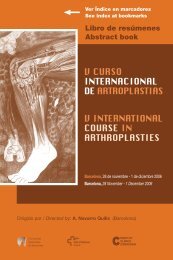Notas / Notes - Active Congress.......
Notas / Notes - Active Congress.......
Notas / Notes - Active Congress.......
Create successful ePaper yourself
Turn your PDF publications into a flip-book with our unique Google optimized e-Paper software.
MARTES / TUESDAY<br />
32<br />
center is only recommended when the dysplastic process<br />
has led to remodeling of adequate bone to support the implant<br />
in this position-most commonly Crowe II. Leg length discrepancy<br />
must be kept in mind and appropriate intervention on<br />
the femoral side made as needed. Crowe III or IV defects<br />
are best treated by bringing the socket to its anatomic location.<br />
Several acetabular component designs have incorporated<br />
the use of a hydroxyapatite (HA) coating to improve bony<br />
ingrowth or ongrowth. Hydroxyapatite is an osteoconductive<br />
material that in animal models, has been shown to optimize<br />
bone attachment to fixation surfaces. The most popular initial<br />
designs that incorporated an HA coating were smooth,<br />
hemispherical components that relied on a press-fit for obtaining<br />
initial implant stability without screws for fixation.<br />
Unfortunately, these components have been associated with<br />
poor intermediate term results as with time, the HA resorbed<br />
and without a biological surface available for osseointegration<br />
to occur, aseptic loosening ensued. In one comparative study<br />
of porous coated cups, HA coated smooth press-fit acetabular<br />
components and HA coated threaded screw in cups, the<br />
highest rate of failure (11%) was seen with the HA coated,<br />
smooth press fit cup at a minimum of five years. In response<br />
to the problems of early failure, HA has since been applied<br />
to grit blasted and porous coated implants with acceptable<br />
results at short and intermediate term follow-up. One clinical<br />
trial that compared a titanium fiber metal mesh component<br />
with and without HA coating among 23 pairs of patients. Although<br />
the clinical results were similar, the components with<br />
HA coating were associated with less migration and fewer<br />
radiolucencies when studied with radiostereometry analysis.<br />
No clear clinical benefits were identified. Similar animal<br />
studies have suggested that HA applied to a titanium fiber<br />
mesh coating enhances early bone ingrowth but there may<br />
not be a longer-term benefit in terms of overall implant stability.<br />
A potential concern with the use of HA coatings is that<br />
as the HA delaminates with time, these particles may enter<br />
the joint space causing damage to the bearing surface.<br />
CEMENTED CUPS: RESULTS AND<br />
TECHNIQUE<br />
A. John Timperley<br />
Princess Elisabeth Orthopeadic Hospital,<br />
Exeter (Great Britain)<br />
THREADED CUPS, WHEN?<br />
Karl Zweymüller<br />
Orthopädische Krankenhaus Gersthof<br />
Wien (Austria)<br />
INTRODUCTION<br />
Although very popular in the late seventies and early eighties<br />
of the last century, threaded cups are scarcely used today,<br />
because the outcome achieved with their first generation<br />
was poor. We introduced in 1985 a new generation of threaded<br />
cups. From 1993 a further development was used. The<br />
aim of this study was to analyse the minimum 10 years results<br />
with this cup and to compare the results with those<br />
obtained with hemispheric cups.<br />
MATERIAL AND METHODS<br />
Between January 1993 and June 1994 400 patients (412<br />
hips) were provided with primary implantations in our department.<br />
After excluding other combinations than ceramicpolyethylene<br />
and the previously used Alloclassic system this<br />
left a group of 365 patients (376 hips) provided with the Biconcup<br />
and SL-Plus-stem. No other cementless system was<br />
used and no implants inserted during that period were cemented.One<br />
hundred sixty-one patients (167 hips, or 72%)<br />
had idiopathic osteoarthritis, 37 patients (38 hips, 16.4%)<br />
had developmental dysplasia, 11 patients (11 hips, 4.7%)<br />
had osteonecrosis of the femoral head, 10 patients (10 hips,<br />
4.3%) had post-traumatic arthritis, and six patients (six hips,<br />
2.6%) had other abnormalities. In all cases, we used cementless<br />
threaded cups in combination with straight cementless<br />
stems with a double taper made of hot forged titanium<br />
alloy (Plus Orthopedics AG) and a ceramic ball head (Ceramtec,<br />
Plochingen, Germany) in contact with an ultrahighmolecular-weight<br />
PE liner (Plus Orthopedics AG). The cup<br />
shells were made of commercially pure titanium. The surface<br />
was roughened through grit blasting. The mean surface<br />
roughness was 5 µm; therefore, no coating was applied.225<br />
patients (232 hips) were followed clinically and radiologically.<br />
The age of the patients was 19.8 – 83.3 years at operation,<br />
mean 62.6, the follow-up time was 10.0 – 13.1 years, mean<br />
10.3. We also evaluated gaps on postoperative radiographs.<br />
Two types of gaps were distinguished. The first type involved<br />
incomplete bony coverage of the metal cup shell in Position<br />
1 (ie, between the cranial circumference of the implant and<br />
the iliac bone). Usually triangular, these gaps were called<br />
cranial dead space or triangular cranial gaps. Their appearance<br />
on 10-year followup radiographs was compared with the<br />
postoperative radiographs to see whether they had become<br />
smaller or were obliterated by newly formed bone. The second<br />
type were gaps between the front end of the implant and the<br />
acetabular floor. Because these were measurable on the<br />
monitor-controlled radiographs, they were determined in 2-





